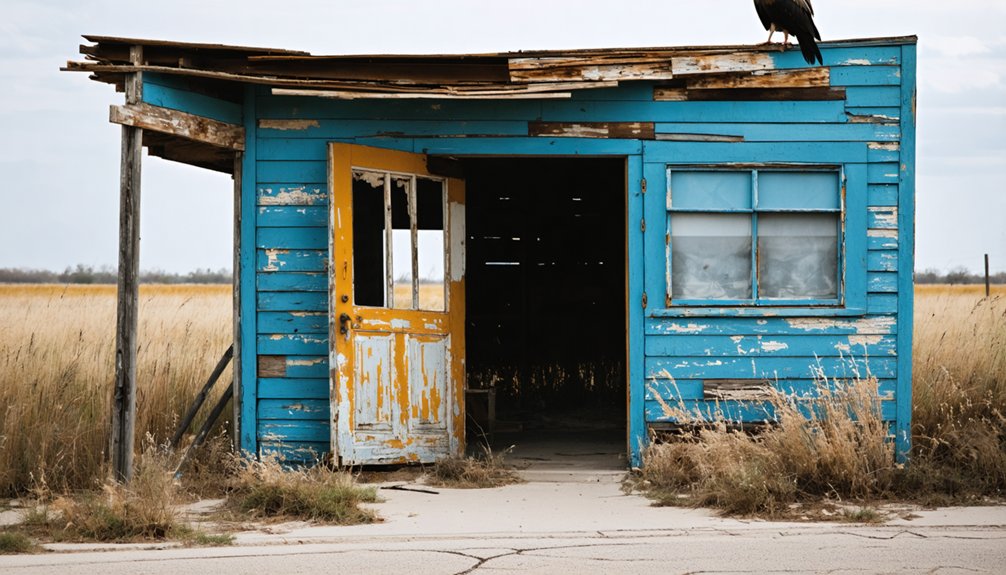You’ll find Narcisso’s ghostly remains west of Paducah, Texas, where Sam Lazarus’s grand railroad dreams fizzled in the early 1900s. The Quanah, Acme and Pacific Railway sparked this frontier settlement, with ten streets bearing names like Dip and Dougie. Despite the railway station’s promise of prosperity, the town couldn’t attract enough settlers or sustain growth. By 1940, isolation and lack of amenities sealed its fate. Today, only weathered mile markers and depot foundations whisper tales of what might’ve been.
Key Takeaways
- Narcisso was a planned railroad town in Texas established in the early 1900s along the Quanah, Acme and Pacific Railway route.
- The town featured ten streets and a railway depot but failed to attract sufficient settlers or businesses despite development efforts.
- Economic challenges, isolation from markets, and lack of basic amenities led to the town’s abandonment by 1940.
- Archaeological remains include railroad mile markers, depot foundations, and traces of the original streets now integrated into farmland.
- By the 1980s, Narcisso had completely vanished from Texas maps, becoming one of many ghost towns from the frontier era.
Origins and Railroad Dreams
Like many Texas ghost towns, Narcisso started as a railroad developer’s dream in the early 1900s. When the Quanah, Acme and Pacific Railway planned its route through the region, speculators saw an opportunity to build a thriving town from scratch. The Narcisso history began when Sam Lazarus, a St. Louis developer, hand-picked the site and gave it its distinctive name. The town was strategically positioned west of Paducah to maximize railway access.
This venture in railroad speculation seemed promising at first. Similar to how the railroad expansion in the 1880s brought towns like Marfa and Alpine to life, the Narcisso Townsite Company mapped out ten streets with ambitious names like Dip, Dougie, and Acme.
They built a cotton platform, depot, tool shed, and section foreman’s house to support the rail stop. You can imagine the excitement as they marketed lots to potential residents and businesses, hoping to transform empty prairie into a bustling commercial center.
Mapping the Lost Town
If you’re looking to trace old Narcisso today, you’ll find the Missouri-Kansas-Texas Railroad‘s weathered mile markers still dotting the landscape where trains once rumbled through.
Like the remains of Old Alton Bridge, only scattered ruins mark where this community once thrived.
The town’s original boundaries have long since blurred into farmland and brush, leaving few visible reminders of the bustling community that once stood here. By the year entirely abandoned by 1940, no residents remained in what was once a promising Texas settlement.
Yet by following the railroad’s path and studying old survey maps, you can piece together where Narcisso’s streets, homes, and businesses once formed this vanished Texas town.
Railroad Landmarks Today
While most of Narcisso’s railroad landmarks have vanished into the Texas soil, you can still map the ghost town‘s rail history using its precise coordinates at 34°00′01″N 100°28′24″W.
If you’re searching for railroad remnants, you’ll find ghostly echoes of the Quanah, Acme and Pacific Railway‘s presence in the foundations of the old frame depot and fragments of the cotton platform.
Today, the agricultural fields have reclaimed where trains once rumbled through. The section foreman’s house and tool shed are long gone, but you can trace Narcisso’s railroad heritage along its ten platted roads, including Dip, Dougie, and Acme. Similar to how all rail operations ceased in 1941, the town’s vitality faded as its transportation lifeline disappeared.
Like many Texas ghost towns, the tracks were pulled up after 1940, leaving only scattered clues to piece together the story of this once-bustling railroad stop. Much like the Missouri Pacific Railroad that once defined Barstow’s early growth, these rail lines were crucial to the town’s initial development.
Vanished Community Boundaries
Before time and agriculture erased Narcisso’s boundaries, the town followed a meticulous grid laid out by the Narcisso Townsite Company.
You’ll find its vanishing borders marked by ten carefully platted streets, including Dip, Dougie, Acme, Hookie, and Houdin, which once promised an organized future for this Texas Panhandle settlement.
If you’re searching for Narcisso’s historical significance today, you’ll need to rely on mid-century maps.
The town’s coordinates (34°00′01″N 100°28′24″W) are all that remain in modern records.
By 1940, the dream of urban development had faded, and farmland reclaimed the acre-sized lots.
The 1954 Map of Plainview provides the earliest detailed view of the area’s transformation from town to farmland.
The original street grid, railway depot, and cotton platform have disappeared from both maps and landscape, leaving only archival documents to tell the tale of this forgotten community.
Life Along the Railway
During the early 1900s, life along the railway in Narcisso centered around the bustling railroad station that connected this small Texas community to the wider world.
You’d find a rich railway culture where workers installed telegraph lines, operated freight services, and kept the essential transportation lifeline running. The station wasn’t just a stop – it was the heart of local commerce where farmers shipped their crops and merchants received goods from distant markets. Prison laborers contributed significantly as convict labor was used extensively for construction and maintenance work. The old cattle loading facility, now private property with restricted access, was once a vital part of the local agricultural economy.
The railway created strong community bonds as families settled near the tracks, their lives synchronized to the rhythm of passing trains.
You’d see workers gathering at the depot, sharing news and stories, while their children attended nearby schools. The station served as a gateway to opportunity, linking isolated folks to big city markets and fresh possibilities.
The Failed Vision
You’d never guess that Narcisso once held grand dreams of becoming a bustling railway town, with its ten uniquely named streets and promised amenities like a cotton platform and tool shed.
By 1940, those railroad dreams had turned to dust as the Narcisso Townsite Company failed to attract settlers or businesses, despite the optimistic marketing by St. Louis developer Sam Lazarus.
The empty streets and unsold lots eventually gave way to farmland, and by the 1980s, Narcisso had vanished from Texas maps altogether.
This stark contrast mirrors towns like Marfa, which transformed from a simple railway water stop into a thriving arts destination.
Railroad Dreams Derailed
While dreams of railroad prosperity lured investors to Narcisso, those ambitious visions quickly hit the buffers. You’d think the QAP Railroad’s arrival would’ve turned this Texas town into a bustling hub of commerce, but fate had other plans.
Despite the railroad’s basic facilities – a cotton platform, depot, and section foreman’s house – the promised economic transformation never materialized.
The stark reality of railroad expansion fell far short of Sam Lazarus’s grand plans. His St. Louis investment dollars couldn’t overcome the economic challenges that plagued Narcisso from the start.
Without additional rail infrastructure or commercial development, the town remained stubbornly dependent on agriculture. By 1940, even the farmers had moved on, leaving Narcisso’s carefully platted streets and empty lots to fade into the Texas landscape.
Empty Streets, Empty Promises
Despite grand visions of bustling streets and thriving commerce, Narcisso’s reality proved far bleaker than its ambitious blueprint.
You’d have found nothing but empty lots where stores and homes should’ve stood, as economic neglect took its toll on those early community aspirations.
The Townsite Company’s promises rang hollow when they couldn’t sell their plots, and the railroad facilities stood lonely against the Texas sky.
Without basic amenities like schools or churches, folks simply wouldn’t stick around. Those carefully platted roads led nowhere, and the isolation from bigger markets like Paducah didn’t help matters.
Traces in Time

Although time has erased most visible signs of Narcisso’s existence, careful observers can still find traces of this former railroad stop scattered across southwest Cottle County.
If you’re willing to explore, you’ll discover archeological findings that tell the story of Texas railroad ambition: foundations of the old depot, remnants of the cotton platform, and hints of the section foreman’s house.
After the town’s abandonment in 1940, the agricultural shift claimed most of the planned streets and infrastructure.
- Original platted roads like Dip, Dougie, and Acme Road now fade into farmland
- Railroad artifacts and building foundations peek through the soil
- Cotton platform remnants remind us of the town’s brief commercial hopes
- Soil disturbances reveal where railroad operations once bustled with activity
Legacy of a Texas Ghost Settlement
The legacy of Narcisso tells a cautionary tale about the unpredictable nature of frontier dreams.
You’ll find ghostly echoes of those ambitious plans in the ten carefully platted streets and the vanished railroad depot where Sam Lazarus once envisioned a thriving community.
Like many forgotten dreams of the early 1900s, this Texas settlement reminds you that railroad tracks alone couldn’t guarantee success.
Within just 30 years, Narcisso’s promise had completely evaporated, leaving nothing but agricultural fields where businesses were meant to flourish.
Today, it’s a reflection of the harsh realities of frontier speculation – a story that repeats across the Texas plains, where countless towns rose and fell as quickly as tumbleweeds rolling across the landscape.
Frequently Asked Questions
Are There Any Surviving Photographs of Narcisso During Its Brief Existence?
Hey there, Instagram would’ve loved Narcisso, but your historical documentation search won’t turn up any surviving photos. Extensive archival research shows no images exist from when folks called it home.
What Happened to the Original Railroad Tracks That Passed Through Narcisso?
You won’t find those tracks anymore – railroad history shows they were likely abandoned by mid-20th century when track maintenance stopped. Most rail lines like this were removed or left to decay naturally.
Did Any Families Establish Permanent Residences in Narcisso?
You won’t find any permanent family life in those parts – records show residential history was limited to just a section foreman’s house for railroad staff. Nobody else ever settled down there.
What Natural Disasters or Events Contributed to Narcisso’s Abandonment?
You won’t find any flood damage or natural disasters that killed off Narcisso – it was plain old economic decline that did her in when the railway couldn’t attract enough folks to stay.
Can Visitors Still Access the Original Townsite of Narcisso Today?
You’ll find ghost town access difficult – there’s no historical preservation at the original site, and with no clear property status or maintained roads, you’re venturing into unmapped territory at your own risk.
References
- https://en.wikipedia.org/wiki/Narcisso
- https://www.islands.com/1914329/terlingua-ghost-town-buried-texas-chisos-mountains-big-bend-region-haunting-abandoned-vibrant-art-community/
- https://en.wikipedia.org/wiki/List_of_ghost_towns_in_Texas
- https://www.thc.texas.gov/public/upload/publications/texas-heritage-travel-guide.pdf
- https://www.redriverhistorian.com/ghost-towns
- https://www.texasescapes.com/TexasPanhandleTowns/Narcisso-Texas.htm
- https://www.texasescapes.com/TOWNS/Texas-Ghost-Towns-5-Texas-Panhandle.htm
- https://www.historynet.com/ghost-towns-terlingua-texas/
- https://discovertexasoutdoors.com/places/narcisso-texas-the-railway-stop-that-never-became-a-town/
- https://discovertexasoutdoors.com/places/narcisso/



